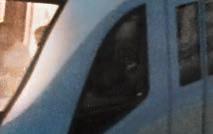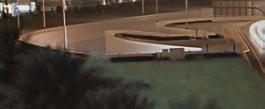


















































Vol. 119, No. 7
Print ISSN # 0033-9016, Digital ISSN # 2160-2514
EDITORIAL OFFICES
1025 Rose Creek Drive Suite 620-121 Woodstock, GA 30189 Telephone (470) 865-0933
Website www.rtands.com
DAVID C. LESTER Editor-in-Chief dlester@sbpub.com
JENNIFER M c LAWHORN Managing Editor jmclawhorn@sbpub.com
CORPORATE OFFICES 1809 Capitol Avenue Omaha, NE 68102 Telephone (212) 620-7200
Fax (212) 633-1165
ARTHUR J. MCGINNIS, JR. President and Chairman
JONATHAN CHALON Publisher
MARY CONYERS
Production Director
NICOLE D’ANTONA Art Director
HILLARY COLEMAN
Graphic Designer
JO ANN BINZ Circulation Director
MICHELLE ZOLKOS Conference Director
CUSTOMER SERVICE: 402-346-4740
Reprints: PARS International Corp.
253 West 35th Street 7th Floor New York, NY 10001
212-221-9595; fax 212-221-9195

curt.ciesinski@parsintl.com
If you are a regular reader of our sister magazine, Railway Age, you likely read editor Bill Vantuono’s note on page 2 of the June issue that Railway Age and Railway Track & Structures have entered a new partnership with the National Railway Historical Society (NRHS) to present the “Outstanding Railroad Historic Preservation Award.”
As Bill writes, “[ e award] is designed to recognize a railroad for its e orts in railway preservation, [with] the intent [to] honor and recognize a North American common-carrier railroad for a historically signi cant preservation project completed or put into operation within the past ve years.”

Bill and I are very excited about our readership participating in the award process because, as Bill points out in his piece, both Railway Age (founded in 1856) and Railway Track & Structures (founded in 1905) are also part of railroad history due to the longevity of our publications. Back issues of RA and RT&S are excellent resources for those working on historical research and we encourage everyone to use them.
I think it’s particularly appropriate that we’re partnering with the NRHS because of its own role in historic preservation. During the 1970s, particularly in the South, NRHS chapters sprang up like wild owers when Southern Railway ran steam engine excursion trips on its lines, known as Southern Steam Specials. e railroad could not provide a lot of the logistics for these trips, such as advertising, selling tickets, assigning passengers to cars, sta ng the commissary car, providing car hosts, and a myriad of other administrative

duties associated with the trips. While the railroad focused on running the trains safely, NRHS chapters provided people to manage all the ancillary administrative and logistical details. is was a win-win-win for everyone. Southern was able to promote railroading in its territory, individuals working or riding on the trips had a relatively rare opportunity to ride a train and interface with a Class I railroad, and the NRHS chapters had a nice revenue stream to help promote their other preservation activities.
It’s fair to say that the NRHS, working with Southern, contributed mightily to growth of rail enthusiasts throughout the country as many came from other parts of the U.S. to ride aboard these trains. Moreover, who knows how many rail enthusiasts exposed to the railroad this way decided to pursue careers in railroad operations or management? I can name several o the top of my head.
I have a correction to make for the June 2023 issue: In our feature on Grade Crossing Surfaces, pp. 22-26, I made an error in the captions of the images on pages 24 and 25. I wrote that the crossings pictured were completed by Omega Industries, when they were actually completed by HiRail. My apologies to Jim Overfelt, Director of Sales & Marketing, and all the folks at HiRail for this error.
DAVID C. LESTER Editor-in-ChiefRaj Wagley, General Engineer, Federal Transit Administration (FTA), Washington,
DCThe Federal Transit Administration (FTA), Metropolitan Atlanta Rapid Transit Authority (MARTA), and ENSCO Rail, Inc. (ENSCO) partnered to demonstrate how autonomous technologies can be successfully implemented in transit operations to help decrease manual walking during track inspection resulting in increased safety and state of good repair. ENSCO and MARTA developed a demonstration project with a phased approach to evaluate the capabilities of several autonomous technologies which comprise the Autonomous Track Inspection Systems (ATIS). e project consisted of installing various types of autonomous track inspection technologies on a MARTA owned vehicle and assessing the technology’s ability to aid in the partner’s goals to improve safety and e ciency.
A unique challenge that transit agencies face is performing walking track inspections. Although most U.S. transit agencies are not governed by the Federal Railroad
Administration (FRA), all have internal track inspection rules that have similar requirements to the FRA’s track inspection regulations, which include recurring manual inspections of the track. However, a major di erence of transit railways (heavy rail or light rail) versus FRA regulated freight railroads and commuter passenger railways is that many transit railways have signi cantly higher train tra c with o en only minutes between trains. Additionally, with the growth of major cities, this transit tra c is continuing to increase. is limits the time that transit tracks can be inspected to either between trains or during short, nighttime durations when a track is outof-service. Inspecting track between trains in a transit railway has unique challenges in that multiple people are required to setup protection for the inspected zone and provide lookout protection. Additionally, trains o en (but not always) operate at reduced speeds in the inspection zones causing tra c delays. For the track inspectors themselves, this is a challenging scenario where critical infrastructure must be inspected quickly, o en times in the dark and with debris on the track.
With all these challenges, transit agencies su er a signi cant safety risk of track inspector or worker fatalities. Tragically there have been multiple track inspector or worker fatalities when the inspectors and workers were struck by a train while performing visual inspections of the transit infrastructure. is issue has risen to the attention of the National Transportation Safety Board (NTSB) with its 2021-2023 Most Wanted List. e list includes only one railway related item entitled “Improve Rail Worker Safety”, which cites that FTA governed transit agencies have had a concerning number of railway worker fatalities caused by moving equipment.[1]
Automated track inspection technologies are already being used on passenger and freight railroads, monitoring track and vehicle behavior and using predictive maintenance to help railways plan for necessary repairs. e FTA is now interested in utilizing the available inspection technology to
reduce the safety risks of inspectors on the track and achieve improved operational safety through technology enhanced track inspections.
e plan to execute the FTA-sponsored demonstration project required a three phased approach. Phase 1 began in September of 2017 when ENSCO began designing the ATIS technology to be installed on MARTA’s work car consist, which included two former revenue service passenger cars operating as a married pair capable of operating during revenue service as shown in Figure 1. is host vehicle was key to inspecting track during the peak revenue service conditions without having track inspectors at risk on the track. Additionally, it was important that inspection took place without negatively e ecting revenue or transit service reliability for the MARTA system.
e speci c technologies for Phase 1 of the program included an Autonomous Track Geometry System (ATGMS), an Autonomous Vehicle/Track Interaction (V/TI) Monitor, and a ermal Imaging System (THIS). Each of these were chosen due to the technologies’ ability to inspect for high-risk conditions in the track and third rail infrastructure. All the systems, with a common location determination system, are synchronized with each other. When above ground, the system uses di erentially corrected GNSS which is the enhanced version of GPS that provides greater accuracy. Also, the system uses previously installed track RFID tags used for station announcements, in the tunnels and underground sections. A RFID tag reader antenna installed on the vehicle is able to identify the tag location when it passes each RFID tag. Specialized logic is used to determine which track the train is on and what its chainage location is (equivalent of mileposts for transit agencies).
Track geometry continues to be one of the most di cult track conditions for track inspectors to visually identify. Autonomously measuring track geometry is
critical because derailment risk conditions can occur quickly, such as rapidly deteriorating ballast or broken concrete grout pads causing wide gauge or track twist. e ATGMS used is the same design used on other railways in both manned and autonomous operations and is comprised of a measurement beam that includes lasers, cameras, and an inertial measurement system. Specialty brackets were designed and evaluated to ensure that the ATGMS beam would operate safely on the MARTA’s former revenue passenger vehicle. e ATGMS autonomously measures whenever the vehicle moves, and automatically processes, reviews exceptions to con rm they are valid, and transmits exception information to eld personnel.
e V/TI Monitor provides real-time detection for potentially unsafe vehicle/ track interaction conditions such as elevated wheel/rail impacts caused by battered or broken frogs, battered or broken joints, engine burns, crushed heads, and broken rail. Additionally, the V/TI
Monitor assesses ride quality and detects truck hunting.
Another unique challenge many transit agencies and transit railways have is overheating third rails and associated components. A common scenario is compromised insulators or power cables becoming overheated and introducing a re risk. is is a condition that is very di cult for a track inspector to identify without thermal imaging. e ermal Imaging System (THIS) includes two cameras installed on the test vehicle looking at both the le and right third rail positions. e THIS cameras looks for “hot spot” locations. During Phase 1, the system operated semi-autonomously by collecting data on its own, but requiring manual o oading.
roughout the program, the ATIS technologies collected data automatically and sent it to a remote server. Measurement data is hosted in an online repository called TrackIT®. Urgent exceptions were immediately sent to eld personnel for veri cation and remediation actions. Much of the data
does not require immediate response but is rather used by track maintenance personnel to identify trends and conditions that require preventative maintenance. Additionally, an O ce Review System (ORS) was provided that includes so ware to review in-depth all the imagery and measurement data. e ORS consists of a workstation computer that enables a Virtual Track Inspection to be performed from the o ce.
In Phase 2, additional technologies were added to the test vehicle. An Autonomous Rail Pro le Measurement System (ARPMS) was installed which determines rail wear and cant angles. An Autonomous Track Component Imaging System (ATCIS) was also added. is machine vision, linescan imaging system captures high resolution images of the track bed that are useful when trying to identify issues with rails, ties, fasteners, slab track structures, and ballast.
Phase 2 saw the expansion of the O ce environment, ENSCO’s TrackIT® Data Management System, to streamline overall




track assessment. By utilizing this webbased interface, MARTA’s Maintenanceof-Way (MOW) workers only need a connection to the internet to access ATIS data. Maintenance workers can sort data based on a number of lters including location, subdivision, milepost, defect type, and severity. It also makes it easy to identify areas of concern that may require additional investigation based on the high number of defects.
So far, the program has been showing promising results, helping to improve eciency and safety for workers and transit customers alike. In 2019, MARTA hosted an industry working group which worked with the FTA’s safety standards program to demonstrate how the ATIS system worked (Figure 2). In the proposed Phase 3, ENSCO and MARTA plan to establish and increase reliance on autonomous inspection technology, including an automated review of imagebased data and an integration of autonomous inspection products into MARTA’s asset management system to aid in its requirements for FTA “state of good repair.”
Future Work at ENSCO’s Transportation Technology Center (TTC) in Pueblo, CO


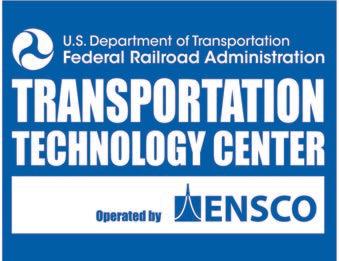
As we adopt more technology into railway operations, it’s important to ensure optimum interactions between the systems and the people working with them. A good example is that technology is very good at finding defective conditions that are difficult for humans to find. But humans still need to perform the field follow up to exception locations to verify, determine remedial action, and ultimately repair the track. Training is needed to aid track inspectors and maintenance personnel to understand automated track inspection information and properly locate the defects in the track. Identifying track defects doesn’t help if the railway personnel cannot find and fix them. The TTC is expanding its handson training to address this very need. The new era of the TTC has the unique ability to have automated inspection technology combined with test tracks with known defects. Students are given
real-world scenarios of receiving reports from the systems and having to go field verify the exceptions, all done under the supervision of industry experts. The goal of the TTC is to achieve optimum safety and efficiency through the pairing of trained railway personnel and cuttingedge technology.

References



1. https://www.ntsb.gov/Advocacy/mwl/ Pages/mwl-21-22/mwl-rph-02.aspx







IT IS GENERALLY AGREED that one of the major indignities hurled at railroad history and American architectural history is the destruction of the Pennsylvania Railroad’s Pennsylvania Station in 1963. The air rights above the station were traded by the railroad in exchange for a smaller underground station (built at no cost to the railroad) and an interest in revenue from the new Madison Square Garden complex that would be built above and adjacent to the property of the former station. Despite valiant efforts to save the station, the wrecking ball began to swing in the fall of the year that also saw the assassination of President John F. Kennedy.
Since that time, Penn Station and Madison
Square Garden (MSG) have co-existed in the same spot, with many decrying the cramped and dour nature of the station that serves intercity rail passengers in the largest U.S. city. In June of this year, that co-existence came under fire in a report issued jointly by Amtrak, MTA, and New Jersey Transit. The report says, in essence, that Penn Station and MSG are no longer compatible. Since the time the “new” Penn Station and MSG were built, according to the report, “the context and operating environment has changed dramatically, both for Penn Station and for MSG.” The report goes on to say that “The complex was built under 1960s building and safety codes and designed to accommodate
approximately 200,000 daily pedestrian trips. Current estimates forecast daily trips will reach as high as 678,000 by 2038. As a result, the Station experiences regular overcrowding and substandard conditions. For its part, MSG was designed primarily as a sports venue. Since then, an explosion in concerts and events have made it one of the highest-grossing arena-sized entertainment venues in the world. It’s 1960s-era internal loading facility, however, is unable to accommodate modern tractor-trailers, and its integration with the Station has not been significantly updated.”
The report adds that “MSG’s site plan and loading arrangements may have been
compatible with Penn Station and the surrounding community in the early 1960s. Today, however, MSG’s existing configuration and property boundaries impose severe constraints on the Station that impede the safe and efficient movement of passengers and restrict efforts to implement improvements, particularly at the street and platform levels . . .”
The Garden’s ten-year operating permit comes up for renewal in July 2023. The three passenger agencies point out in their report that “The Railroads have begun discussions with MSG regarding the improvements envisioned in the [agencies’] Master Plan effort, but an agreement has not yet been reached.
If MSG does not agree to take the necessary steps to ensure compatibility, the required finding of compatibility may not be able to be made by the City Planning Commission and the Railroads may recommend that the new special permit not be granted. The Railroads will continue their engagement with MSG in pursuit of an agreement that will enable the Railroads to achieve their goal of transforming Penn Station into a 21st-century, world-class facility that provides safe and accessible passage for MSG and Station users alike.”
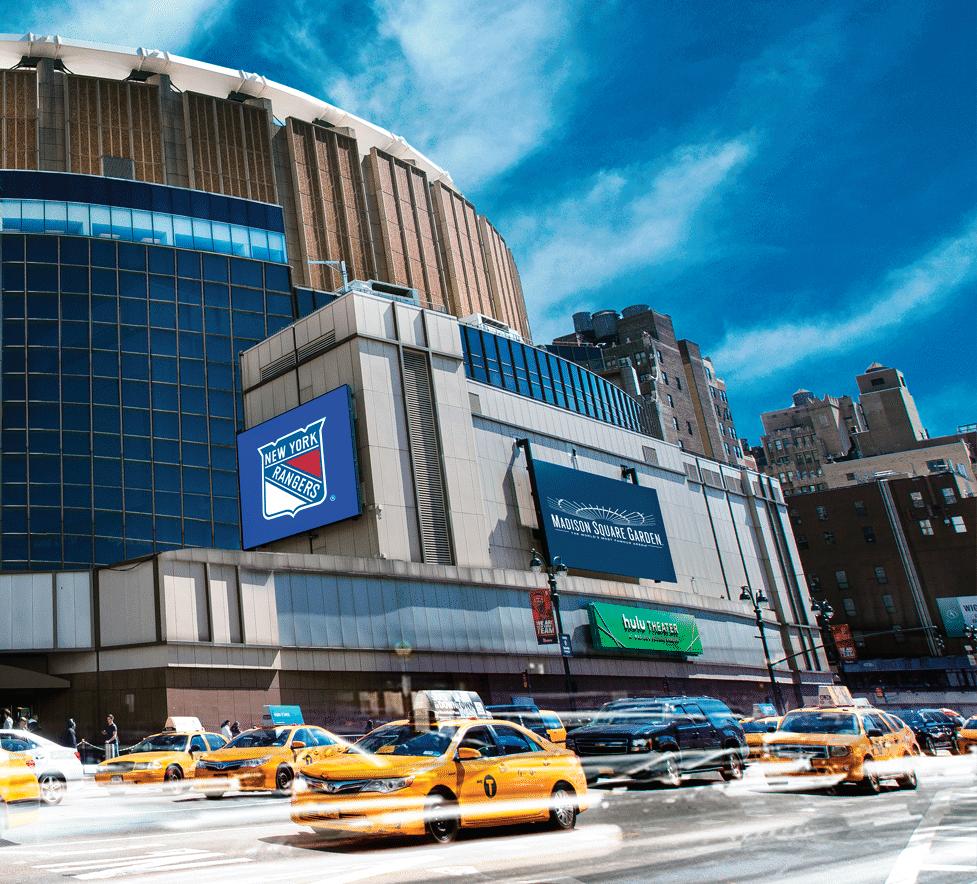
You can find the compatibility report at https://www.amny.com/wp-content/ uploads/2023/06/MTA-Amtrak-NJT-Penn-
Station-Compatibility-Report-on-MSG.pdf. You can also read more about this issue in “The Way Things Work – Money, politics, and the public good in the fight over Penn Station and Madison Square Garden” in the March 13, 2023 issue of The New Yorker, pp. 44-55.






There are times in life that deserve recognition and celebration. Anyone who has competed in athletics knows what I’m talking about. I relished those moments when my teammates and I won our individual races, set personal best times, and took the University of North Carolina Tarheels swimming team to victory. e trophies and the cheers from our fans felt good and they propelled us to work even harder. Sometimes they even gave us the edge to achieve more than we could imagine.
Once you’re out in the working world, there are no cheering squads. Opportunities to earn recognition for exceptional performance for yourself, your co-workers, and other jobsite partners are few and far between.

But if you are a member of the NRC, you’re in luck. Every year we give our members the opportunity to honor rail industry profession als by applying for a full range of awards. It’s easy to apply for these substantive awards that provide well-deserved recognition for indi viduals, teams, and their companies. Award winners are honored at our annual conference
Safe Contractor of the Year
January the NRC honored more than 45 contractors with platinum, gold, or silver awards for exemplary safety performance during the prior year. Contractors who participate say it is a tremendous honor for employees but also provides the side bene t of evaluating and keeping their safety programs up to date with industry best practices. is award also serves as a valuable business devel opment and marketing tool.
Construction Projects of the Year –
e NRC honors exemplary projects in two categories: large projects (with budgets more than $10 million) and small projects (with budgets less than $10 million). Rail construc tion projects of all types are evaluated for successful execution in the areas of innova tion, expertise, safety, and quality project management. ese are fascinating awards that showcase the amazing work performed by our members.
Field Employee of the Year
award honors the unsung heroes of railroad construction. e presentation is always emotional because our members know the
dedication and hard work required to be an exemplary eld employee. Winners of this award are leaders who go above and beyond what is required, demonstrate innovation and perseverance, and possess a strong commit ment to safety and customer satisfaction.
Innovation in Technology – We know from our annual conference that railway engineering leaders continually request help with technology solutions that will gener ate returns on investment and bottom-line savings. is award debuted at our last confer ence to highlight ways our members are using technology to enhance safety and operations in our industry.
Hall of Fame – Although not given every year, this award honors industry MVPs who have made signi cant contributions to the NRC and the rail construction and mainte nance industry.
ose awards are great, but awards with money may be even better. e following award is one of the ways the NRC shows its commitment to investing in educational endeavors that recognize potential and help students excel.
Scholarship – I’m pleased to announce two exciting changes to this award. In addi tion to children and grandchildren of NRC member companies, employees themselves are now eligible to apply for this scholarship.










e NRC also has added an additional $3,500 scholarship for trade-school students to the existing $21,000 for three undergraduate scholarships.
ese are tremendous opportunities to recognize and celebrate exceptional accomplishments. It’s time to take action while this is top of mind. e NRC is accepting scholarship applications now and all other award applications open up in the fall. Check our website for eligibility and application details: nrcma.org/nrc-awards
“Building a Safer and Stronger Railway Construction Industry Together!”



















THESE ARE TREMENDOUS OPPORTUNITIES TO RECOGNIZE AND CELEBRATE EXCEPTIONAL ACCOMPLISHMENTS. IT’S TIME TO TAKE ACTION WHILE THIS IS TOP OF MIND.








































Network and collaborate with a diverse group of women and allies who are making a difference in the rail industry. Learn how railroaders can maintain the momentum of inclusion, build strong support networks, and take advantage of ever-broadening career opportunities.
•Discover career advancement and development opportunities














• Learn about the career paths of women leaders and how today’s railways are supporting them




•Explore DEI (Diversity, Equity and Inclusion) initiatives






















• Learn about mentorship best practices—from finding a mentor, to serving as one
•Discover how ERGs (Employee Resource Groups) are established for community building and support
•Connect with your peers— both upcoming talents and accomplished women in rail
REGISTER: www.railwayage.com/womeninrail
SPONSORSHIPS: Jonathan Chalon | jchalon@sbpub.com | 212.620.7224

 By David C. Lester, Editor-in-Chief
By David C. Lester, Editor-in-Chief



Congratulations, Katherine Barry for being recognized as one of Railway Track & Structures Women in Engineering
Leading our signal design team as Senior Manager, Signal and Electrical Engineering, Katherine has a key role in ensuring our trains run safely and efficiently. Over Katherine’s 12-year career with Norfolk Southern, she has been responsible for leading significant, wide-reaching efforts that have improved our ability to safely deliver for our customers and communities. We are proud to honor her for this recognition and thank her for the impact she has made to creating a railroad of the future.
 ©2023 Norfolk Southern Corporation
©2023 Norfolk Southern Corporation
Railroad engineering is a complex and demanding field. You don’t get partial credit if the bridge falls down. Becoming an engineer requires rigorous education just to earn your ticket to participate. Then, the unique demands of maintaining the infrastructure of a business that features massive structures, large and heavy rolling stock, track and roadbed to support it all, and solving problems that don’t have an obvious answer are not for the faint of heart. This year’s honorees bring skill and dedication to their work every day. We are proud to showcase this group, each of whom was nominated by one or more of their peers. The nominators prepared the brief biographies and list of accomplishments for each honoree.
Has held design positions in both structures and track departments in addition to previous experience as a structures supervisor. With real estate background makes for a strong railroad designer. Engineer-inTraining (tests for PE in August) AREMA Committee 1 (Subcommittee Leader on Culverts). BNSF Achievement AwardBellefontaine Bridge
Coordinates HS Students Studying Abroad Locally - places students with families as well as regularly hosting international students at home.
Felicia brings a good spirit to the railroad and wants to get things done. She is impactful in her work and has a strong background in both track and structures - rare quality
amongst railroading professionals. Soon will be a professional engineer and sky is the limit.
Over her 7-year career with Union Paci c Railroad, Sarah obtained a wide range of eld experience that has established her as a leader both at work and within her community. Sarah started her railroad career back in 2014 as an intern for the Twin Cities Service Unit, where she learned the various aspects of a Class I railroad’s engineering department. Once completing her Civil Engineering degree at Missouri University of Science and Technology, she returned to Union Paci c and completed the Operation Management Training (OMT) Program. Sarah has had multiple management roles within the UP operating department and is currently the Senior Manager of Vegetation responsible for the entire UP network. Sarah has never been one to back down from a challenge and is always looking to implement innovations to advance the railroad. In a former role, she led the battery tool initiative at UP to upgrade the engineering gangs’ track tools. Her team is currently developing new on-track spray equipment that is modernizing the way vegetation is controlled on the UP network. Developing people and leading a team is no easy task, but Sarah has done so successfully across many di erent service units. Her leadership skills also extend to outside of work, where she volunteers at Lake Manawa Sailing Association as a sailing instructor and public media person. In addition, she assists the AFS Intercultural Organization, where she acts as a foreign exchange student volunteer, working as a foreign exchange student liaison and orientation coordinator, and has hosted three High School exchange students over the last few years.

Completed Operations Management Training Program, Member of AREMA Committee 13.
Vice President and Cofounder
Zephyr UAS, Inc., dba Zephyr Rail
Amazing, hard-driving, and compassionate leader who gives more to her team than she expects in return. Always looking for a way to innovate and improve what engineers and rail can do for society, Jackie never seems to
 Sarah Mueller
Sarah Mueller
sleep and always approaches the day with positivity. Jackie Patterson has always strived for excellence. When 19 years old, she escaped war-torn Nicaragua, landing in Canada, learned English and French while at university, moved to the U.S. and went on to become an industry leader in rail design and construction management. Jackie is the role model young women should emulate. A world-class engineer, a considerate mentor, a devoted mother, Jackie Patterson personies what it is to be a civil engineer and a world steward.
BS Civil Engineering, Concordia University Montreal. Civil Engineering Medal – highest ranking graduate - rst woman and rst person of Hispanic heritage to receive the award. MS Civil

Engineering, Concordia University Montreal. EdD in Organizational Change and Leadership in process at University of Southern California. Habitat for Humanity, WTS scholarship endowment. Teaches railspeci c engineering courses at University of Southern California.
Rail Engineering Design Manager
RailPros
Mindy White is an exceptional candidate for the RT&S Women in Rail Engineering honor due to her remarkable qualities and contributions. She consistently demonstrates her commitment as a leader, managing the rail team encompassing both rail designers and engineers, while
collaborating e ectively with various discipline groups and project stakeholders to ensure adherence to designs and standards. Mindy goes the extra mile by mentoring junior sta , helping them develop and enhance their engineering skills. Her dedication and pursuit of service excellence bene t both her team and clients alike. Mindy’s remarkable achievements, coupled with her advocacy for women in engineering and extensive volunteer work, showcase her as a true role model in the eld. She embodies the qualities and accomplishments deserving of this prestigious honor.
Nao is a tremendous asset to Brightline’s MOW team, based out of our Orlando o ces, as we continue our progress on our massive Orlando extension project which will connect Central and South Florida with higher-speed intercity passenger rail. Her engineering knowledge combined with her personality and engagement abilities set her apart and have positioned her as a leader on our team and in her eld. Whether it’s in the o ce, in the eld, or assisting other teams to engage with our stakeholders, contractors, or even community members, Nao’s style, approach and expertise is incredibly valuable as we continue to forge new pathways in the railroad industry. We are lucky to have her on our team!
KAREN PRISCILA
CASTRO RIOS
Project Design & Construction Manager, Junior
Canadian Pacific Kansas City de Mexico (CPKC)
Karen is a deserving candidate for this honor due to her immense passion for collaborative work at CPKC. She plays a pivotal role in expanding network capacities and assists her colleagues in developing their skills. Her 10-year career at CPKC is marked by remarkable growth and impressive results in the railroad industry, which she takes pride in. Karen is a leader both within and outside the company, and her enthusiasm for developing youth is infectious.
KATHERINE BARRY
Senior Manager, Signal and Electrical Engineering
Norfolk Southern
During her twelve-year career with Norfolk
 Mindy White
Mindy White
Southern, Katherine has made signi cant contributions to promote a safer and more
e cient railroad. She began her career at Norfolk Southern as a Management Trainee
before becoming a Signal Engineer. She earned progressively more responsible
Congratulations to Karen Priscila Castro Rios, CPKC de Mexico, Jr. Project Design & Construction Manager, on being honored as one of Railway Track & Structures Women in Engineering.



cpkcr.com


positions, and she now leads the company’s signal design team as Senior Manager,






Signal and Electrical Engineering. roughout her career at Norfolk

Southern, Katherine has been responsible for leading signi cant, wide-reaching e orts


SENIOR COMMUNICATIONS ENGINEER
Recipient of a Women in Engineering Award!

The Modern Railway Systems family thanks you for your commitment to excellence and dedication to our customers in design and engineering.

modrailsystems.com
that have improved the railroad’s ability to safely serve customers. She developed
and updated standard plan sets used for both crossing designs and signal designs. Over a two-year period, she managed the design for more than 100 crossing projects. From 2013-16, she managed Positive Train Control Signal Design for over 400 miles of track. is e ort was one of Norfolk Southern’s most ambitious signaling projects in recent memory. She took a limited amount of eld experience and training and immediately applied it successfully to the design environment during the PTC installation. Most recently, she led the Advanced Train Control (ATC) team that performed breaking analysis to facilitate the transition to Tons-Per-Operable-Break (TPOB) timetable speeds. Katherine’s work enables the Transportation department to have more exibility in train consist makeup and keeps operations uid.
Katherine has shown a strong work ethic throughout her career at Norfolk Southern. She has proven herself adept at navigating complexity and building e ective partnerships both within and outside of the company to advance the success of

signi cant projects.


Amtrak
Production
Kristin has been my [nominator’s] peer since I joined Amtrak in 2016. She has an excellent attitude and inspires others to do the right thing. Kristin holds her own in a challenging industry and still shows up with a smile and an open mind. She’s learned from experience and is applying the lessons she’s taken to heart to advance the Amtrak production team. In the seven years I have known Kristin, she has supported me through many challenges and I’ve been grateful for the opportunities I have had to lend her the same support. Amtrak is lucky to have Kristin leading the production team, and she deserves recognition for her dedication and commitment to the industry.
BETHWe want to congratulate Mindy White, Rail Engineering Design Manager, on being one of the RT&S “2023 Women in Railroad Engineering.” Mindy is an experienced professional, and a passionate advocate for women in engineering, frequently volunteering her time and talent to inspire young women to pursue careers in STEM. Thanks for everything you do for the team and the industry, Mindy!
Beth was a single mother who worked as a ski li operator, movie theatre manager, bank teller and bartender. To save money, she was continuously teaching herself skills like car repair. When her daughters were teens, she wanted a more stable job and applied as a warehouse clerk at a small communications company called Rail Services Corp. People quickly saw her aptitude and hard work and she trained to become a communications engineer instead.
Everyone who works with Beth speaks very highly of her excellent work and attitude. Her designs are strong and her troubleshooting skills are unmatched. She continues to learn and seek new challenges. Beth is indeed the “best of the best” as a communications engineer in the railroad industry.
Senior Manager Advanced Technology Development
Canadian National Railway
One of the hardest working women in
industry and consistently pushes to drive products to completion, have worked alongside and learn from her daily.
A er earning degrees in Biomedical Engineering and Electrical Engineering from Duke University, Andrea started her career as an electrical design engineer for a large semiconductor manufacturer. In 2006 she pivoted to the rail industry, advancing state-of-the-art track evaluation technologies in both engineering design and product management capacities.
She joined CN in 2021 as the Senior Manager of Advanced Technology Development for the Engineering Department. The technologies her teams deploy generate key safety improvements, influence capital deployment strategy, and drive databased business decisions and solve business challenges.


In addition to her technical degrees, she holds an MBA from the Kellogg School of Management at Northwestern University.
Congratulations
Chief Technical O cer
voestalpine Railway Systems Nortrak




Stacey Schmidt, Chief Technology O cer at voestalpine Railway Systems Nortrak (Nortrak), has been shaping new ways of doing things in the railroad industry since joining the company in 2016. She is a visionary leader with deep experience in transforming technical and design methodologies to build on Nortrak’s technical and industry reputation for excellence. Stacey leads some of the company’s most strategic functions—R&D, engineering, and quality—with a clear passion for continuous improvement. Her leadership and vision reshaped engineering at Nortrak by implementing the Siemens NX design platform coupled with fostering automation, creating standardized template designs, and upgrading processes, resulting in increased e ciency, a reduction in errors, and most importantly, reduced customer lead times.
Stacey brings more than twenty years of experience working in the energy and defense sectors and has a unique perspective on the industry. Her ability
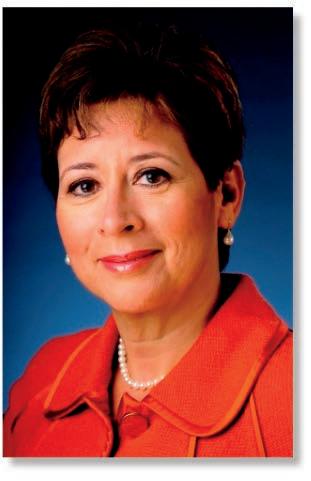

to question, challenge the status quo, and adapt with creative problem-solving helps engage Nortrak’s technical team to solve some of Nortrak’s and our customers’ most challenging problems. She holds a Bachelor of Science in Mechanical Engineering from the University of Missouri - Columbia, an MBA from Baker University, a Professional Engineering License, and her Project Management Professional certi cation.





Jennifer is unique among her peers. From the day she joined HNTB, she has been very ambitious and competitive, but she has never felt she was owed anything. Her dedication and work ethic are immense. Where others would reach a certain career milestone in ve years, Jennifer gets there in three. What others would accomplish in 10 years, Jennifer does in seven. Over the course of her career, looking at the number of promotions she has earned demonstrates her meteoric rise. She is fully invested in her
career. At the same time, Jennifer excels at people skills. She instills con dence in clients. Her leadership of SPAN has helped to create a work environment that adds to team members’ job satisfaction and enjoyment in working with one another. Jennifer has a well-rounded, holistic approach both to work and life. She has achieved a dynamic rise at HNTB without sacri cing relationships or work-life balance. “When Jennifer joined HNTB, she and I were the only members of the track section group in the New York o ce,” said her supervisor, Rob Dall. “I would never take credit for her success. Mostly I just had to give her opportunities and get out of her way. Jennifer welcomes challenges that take her outside her comfort zone, and that’s where she has always performed best. I’ve always relied heavily on her to step into roles she hasn’t had before, and she rises to the occasion and delivers work at the highest level. Fear will never stand in her way, and she is never going to hesitate to take responsibility for challenges that represent growth opportunities. Jennifer is a future leader,
Fasteners are simple in that the name accurately and succinctly describes their function. An element of track and roadbeds, fasteners allow rails to be securely attached to ties. An integral part of track structure, the importance of these devices cannot be overstated. What follows is but a small array of the fasteners currently o ered by six vendors.
A Caterpillar company, Progress Rail o ers a line of fastening systems for haul and transit railways worldwide with products such as the ADFF55 high attenuation direct xation fastener, the Loadmaster DF, and the e-Style Clip. With Progress Rail’s DF Block System, it enhances the

direct xation track construction and fastener installations while simultaneously eliminating the risk of improper concrete setting, honeycombs, and irregular surface conditions.



When the city of Los Angeles used the DF Block system, installation time was reduced along with material handling and required personnel. e DF units’ life expectancy is enhanced, especially when side by side with a previous top-down construction technique. In addition to fastening systems, Progress Rail o ers other trackwork solutions, including turnouts, DF and ballast mats, li frogs and crossovers for transit, and commuter and HAL applications. Products
can be utilized at-grade, elevated structures, or tunnels.
Rail fasteners for slab track, concrete, and wood ties are part of Voestalpine Railway Systems Nortrak’s range of systems solutions. A provider of trackwork, Nortrak is the only fastener supplier with in-house production in North America that includes the production of concrete ties, ductile iron and injection molded plastics. ese allow Nortrak to develop and design its own supply chain to provide value to freight and passenger railroads.
Along with concrete ties, cast tie plates, plastic pads and insulator rail clips, Nortrak’s product line includes the NT2060


Safelok I style long reach clip that is in use by many Class Is. In its e ort to esh out its product line and complete its systems for most concrete tie fasteners across the U.S. and Canada, Nortrak is currently working on its heavy-duty insulators for Safelok I and e-Clip applications.


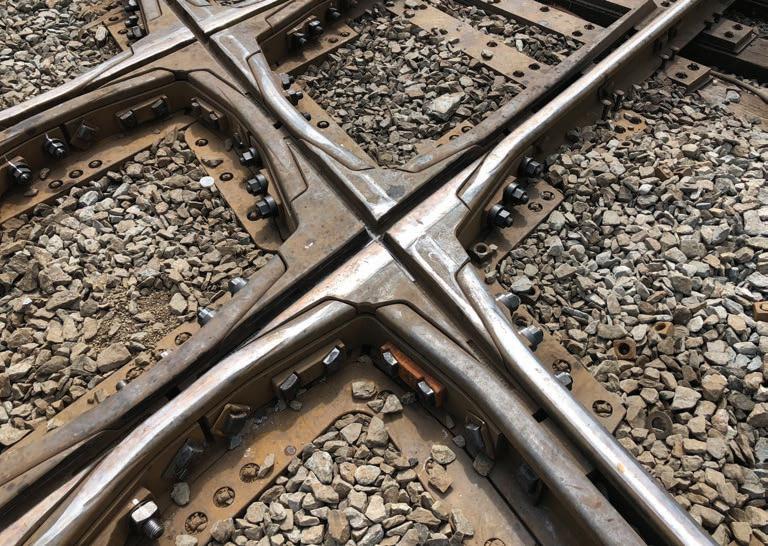
Nortrak has also developed more than thirty direct xation fastener designs that include high attenuation fasteners with a sti ness pro le of forty thousand pounds per inch to a standard attenuation with a sti ness up to two hundred thousand per inch. Senior Vice President of Strategy & Corporate Development, Fixation Systems, John Stout, told RT&S that due to
“Nortrak’s ability to develop fully rubber bonded fasteners using in-house design, tooling, and production designed to its operating environment, it is able to deliver products that are reliable and necessitate less maintenance over time.”





In its rail fastener o ering, Miller Ingenuity provides the ReLok fastener system. It is a vibration-proof, selflocking nut and is designed to increase the hardware lifecycle and subsequently reduce maintenance expenses. Miller Ingenuity’s ReLok fastener system is designed so that the annulus of the nut is forced into the collar during vibrations. In turn, it captures, retains, and delivers that energy back to the
joint as a way to de ect shock and vibration. Because the system is a locking fastener, it is possible to use for multiple installations with the original amount of force. e ReLok fastener system was updated to include fewer parts, making installation easier. In terms of testing, the fastener system was tested at a Diamond test location in Bremen, Georgia. With lateral train forces and the addition of vehicles running across the intersection causing other fasteners to fail, Miller Ingenuity’s ReLok fastener system held up to the testing.
Another industry leader, L.B. Foster has developed and commercialized vulcanized bonded direct xation fasteners for North



A small device with a big job to ensure safety
American transit. In business for over forty years, L.B. Foster’s Transit Products Division works to develop solutions for its customers. e company has supplied fastener designs across the U.S. and Canada. ese designs include performance characteristics such as rail seat height, anchor locations, lateral adjustment, cant requirement, sti ness and resiliency, as well as performance coatings. With the addition of vulcanized rubber bonded direct xation
fasteners, L.B. Foster’s product line comes with complete assembly with the least number of components possible, allowing for ease of installation and maintenance.
L.B. Foster leverages advanced technologies including nite element analysis and state-of-the-art test equipment through collaboration of its Pittsburgh R&D and Atlanta Transit Products Engineering and Laboratory teams. rough this, L.B. Foster is able to develop and expand its current

product line. With the Fastclip Baseplate, Pandrol also works to develop new and innovative products. An improved version of the Fastclip Baseplate has been engineered to address a range of installations. With the addition of a new line of Sicut composite ties, particularly in bridge settings, it has undergone re nement to ensure optimal performance. Pandrol has taken into account the environmental factors in its
Locomotive mounted autonomous track inspection systems for geometry measurements and fastener conditions

Data analytics
Innovative Track Technology Solutions


Maintenance platform
www.kawasaki-track.com
development of its Fastclip Baseplate, and it has created a solution that guarantees track stability, provides long-term reliability, and minimizes any disruptions that may occur. Its Fastclip Baseplate has undergone rigorous testing to ensure it ful lls requirements for spike retention, compressive strength, and resistance to baseplate cutting. erefore, it has created a reliable and cost-e ective product for railways.





Moreover, the Fastclip Baseplate was engineered to work well in non-ballasted track applications by providing both vertical and lateral adjustability. Catering to a variety of project needs, the baseplate also has damping properties that allow it to surpass noise and vibration requirements for passenger rail. It is also customizable in regard to track sti ness and rail clamping force requirements.
Allen Go , Senior Director of Sales for Pandrol, told RT&S that every “version of the Fastclip Baseplate [is] highly suited for mechanized installation, which improves both e ciency and safety. e Pandrol CD-200 IQ and CD-400 SP are excellent


machines that will work e ciently with the Fastclip Baseplate.”


Founded in 1966, Industry-Railway Suppliers is an exclusive railroad distributor of J.Lanfranco THU locknuts across the U.S. It is also a distributor of AREMA track tools, abrasives, heavy railroad equipment, work equipment wear parts, and mechanical shop tools. Since 1974, J.Lanfranco has created safety-critical locknuts for use in railroads as well as military vehicles, factories, and mining equipment. e locknut is available in sizes up to 2-1/2” and can be used with all standard track or frog bolts.

Service proven in Turnouts, Diamonds, Bridges, and Switches, the THU locknut has self-locking technology and can resist vibration, shock, or impact. is allows the THU locknut to keep infrastructure in peak operating condition whilst maximizing track time.

Its dual locking slots also function independently of bolt tension, keeping the bolt from becoming damaged and allowing for reuse. ese locknuts are also antigalling, not requiring anti-seize paste or



grease, and are resistant to adhesive wear. IRS told RT&S that “J.Lanfranco THU locknuts will decrease waste by lowering labor costs, reducing track maintenance time and service interruptions, and reducing damage to railroad components and castings.”





With this lineup from six vendors, there are quality fastener systems to ensure a smooth application when constructing and maintaining track infrastructure.








Track maintenance is comprised of several fundamental aspects. We’ll review some of these in this article. Maintaining trackwork requires several machines, tools, and processes. Focusing on ve vendors, these companies o er an array of units and services that contribute to track maintenance.

Anticipating track maintenance, Kawasaki Track Technologies o ers monitoring data and so ware solutions. Among these is an autonomous track component monitoring system. Kawasaki’s monitoring system is installed on a locomotive and captures high-resolution photographs to provide data to Kawasaki’s algorithms.
ese algorithms can locate and analyze track components, such as fasteners, that need to be repaired. Kawasaki began testing these on railroads a year ago in Japan before testing on North American railroads this year. Kawasaki told RT&S that “production systems will be available in early 2024.”
Kawasaki also has had a locomotivemounted autonomous track geometry monitoring system available during the last two years and is currently working on a design for more accurate track monitoring. is so ware platform will begin beta testing this fall. Ryoji Negi, a program manager for Kawasaki, told RT&S, that Kawasaki is “excited to bring locomotive-mounted autonomous inspection technology to the North American marketplace. With this innovative technology, any time the locomotive is moving and pulling passengers or freight, it is testing track and providing a frequent, valuable, cost-e cient service to our customers . . . is is another building block for Kawasaki’s vision of providing a complete suite of autonomous track inspection products along with predictive data modeling and platforms to provide our customers with the ability to be more ecient with their track maintenance spend.”
Welding is another important track maintenance technology. RailWorks o ers Flash-Butt Welding services. Along with other services such as thermite welding and grinding, they provide ways to maintain the health of track. However, it is the growth of ash-butt welding that is at the focus of their trackwork maintenance o erings.
Jacob Alexander, Director of Operations for RailWorks, told RT&S that “the growth of ash-butt welding has continued to increase year-over-year. . . At RailWorks, we have also been able to keep up with the growing demand for ash-butt welding by expanding our eet to more than 40 specialized mobile welding trucks.” e eet includes AC and DC welders which can perform in harder scenarios with two unique narrowhead welders. e units boast functionality and exibility with class-leading weld quality and consistency to make the trip from point A to B.
RailWorks’ units come with features that maintain high standards of function with unique rail preparation equipment and an automated weld cycle that does not require operator input. Powered by a purpose-built control system and paired with predictive forging force and weld variance tracking, RailWorks o ers sophisticated mobile ash-butt welding.

For its future, RailWorks’ Vice President of Maintenance of Way, Jason Deaton anticipates a continuing growth as long rail comes online and demand for ash-butt welding increases, as well as thermite welding from Class Is. He told RT&S that these “products become more attractive when the railroads see the bene t. eir failure rate is much lower, and they take advantage of the track windows. By doing so, more work can be
performed safely in a tighter timeframe and showcase better results. It also raises track speeds and keeps revenue trains moving.”
Moving to Omaha Track, it has over four decades of service in trackwork and providing reliable tampers. With trackwork services that specialize in performance, e ciency, and quality, Omaha Track can deliver optimal results. Omaha o ers tamping, leveling, and compacting track and switch systems along with maintenance. Its equipment, including the Jackson 6700 and Mark 4 machines with Jupiter 2 operating systems, allows for accuracy in track level and alignment. Its team of professionals brings a high standard of service, precision track position, reduction of derailments, and enhancement of track safety. Omaha Track’s services have brought a growth in performance and e ciency by reducing wear and tear and maintenance costs whilst improving velocities. Omaha Track told RT&S that it takes “pride in [its] commitment to reliability and quality, exceeding industry standards by leveraging skill and technology.”
While bene ts from dual-treating ties - including, but not limited to, protection of ties during air-seasoning, helping to prevent stack burn, and extending life of service - are signi cant, there were limits because of the challenges of dual treatment. Because dual-treating takes time to allow
for an air-seasoning period, tie replacement has a lasting and challenging logistical e ect on lines and railroads involved. Nisus o ers a BTX Tie Extender System to overcome these limits. Nisus’ o ering ensures green bridge ties are dual treated in the time frame allowed so that they can have a longer service life.


In Nisus’ BTX Tie Extender System, reservoirs lled with Cellu-treat Liquid Disodium Octaborate Tetrahydrate (DOT) are drilled into the green bridge ties before being sealed with BTX plugs. e ties are then pressure-treated with QNAP Copper Naphthenate. e Cellu-treat is pulled through the inside of the tie during the Boulton cycle, thereby protecting the heartwood. Je omas, Eastern Region Manager
for Nisus, told RT&S that the “process provides the bene ts of both borates and copper naphthenate without incurring the time loss incurred from dip-treating and air-seasoning. In the eld, those treated bridge ties can be even further protected by applying QNAP2 to eld cuts and drill holes.”

For work involving rail ties and timbers, Stella-Jones can meet Class I needs, namely the treating capacity, supply sources, and purchasing power. With a supplier network of over 850 hardwood sawmills, Stella-Jones o ers crossties, switch ties, and timbers in varying sizes and species of wood.
e company o ers a complete line of pressure treated wooden railway products from its 12 industrial treating plant
locations. With a primary product line consisting of crossties, switch ties, bridge timbers, fabricated bridges, and timber highway crossing panels, these products can be o ered in Creosote, Copper Naphthenate, and Borate pressure treatments. ese can also be manufactured to meet any railroad speci cation in North America. Additionally, Stella-Jones o ers pre-boring and pre-plating services at several of its locations. A representative from Stella-Jones told RT&S that next year, “in 2024, [it] will continue to invest in robotics, automation, and special projects like the recent solar panel installation in Clanton, Ala. is, rst in our industry, project is already saving the emissions equivalent of 92,000 gallons of diesel fuel each year.”
Operating practices on North American railroads have changed within recent years. Precision Scheduled Railroading (PSR) and its variants, which have been adopted by most of the Class I railroads, have led to changes in train lengths and speeds. In some cases, railroads are running shorter and faster trains; in most cases, they’re running longer, heavier, and slower trains.
“Each operating regime has difference requirements, but in either case, one of the fundamental aspects of PSR is to do more with less — fewer cars, locomotives, yards, crews, staff, and less track, where

it’s not needed,” Gary Wolf, President of Wolf Railway Consulting, told participants at the WRI 2022 Wheel/Rail Interaction conference. More specifically, he said, PSR and its variants focus on:
• Fewer touches per car – less switching, more destination blocking
• Car performance; less on train performance
• Car/train velocity; less on terminal dwell


• Fewer unit trains; more complex blocking
• Optimizing network, not just single divisions/terminals
• Longer full-tonnage trains; filling out tonnage enroute





• Running on schedules; more predictability
• Less firefighting; knowing what to expect
• More flat switching; less humping
• Driving decision making to the local level; less bureaucracy
“The bottom line is that we’re doing more with less,” Wolf said. “But whenever you have higher utilization of assets, you’re going to have accelerated degradation of those assets. We have to understand that we’re putting more stress on
fewer components, and that wheel and rail wear, ballast conditions, and other aspects of track are all going to change — dramatically, sometimes.”
The operational changes associated with PSR affect track maintenance, and they have the potential to affect the derailment causation. “Underscore potential, Wolf said. “I’m not saying this is happening. But I’m here to sound the warning that those of you involved in the track structure, track maintenance, or derailment prevention should be aware of these factors.”
Wolf, who is the author of The Complete Guide to Modern Derailment Investigation, knows of what he speaks. He cited data (from an article by Bill Stephens in the November 2021 issue of Trains) indicating that all of the Class Is regularly operate trains up to 12,000 feet or more. Systemwide averages on the big six systems range from 6,900 feet at BNSF to 9,359 feet at Union Pacific. Since adopting PSR in 2018, UP’s train length has increased by 30%, with a goal of increasing its average train length to
more than 10,000 feet.
With longer trains comes higher tonnage. Concurrent with that, train speeds have declined industry-wide from an average of 25 mph to 20 mph over the past two and a half years, Wolf said. “Lowering train speeds by 5 mph can have a significant effect on lateral curving forces. As speeds decline, we may find that we have excessive elevation in curves. The superelevation that was set based on timetable speeds and operating practices 10 or 20 years ago may be dramatically different from what is required by operating parameters today.” Improper rail cant, which can be caused by improper curve elevation due to changes in train speeds, can lead to differential plate cutting on timber ties. “This reduces the b/h ratio to initiate rail rollover, and ultimately will lead to greater risk of rail rollover, especially on the low rail side. Excessive plate cutting on the low side of the curve due to too much elevation can actually increase elevation and worsen the situation,” Wolf said.
Long, heavy trains can also generate dynamic slack effects that manifest themselves at the wheel/rail interface and are transferred into the track structure. “Braking longer, heavier trains on long downhill grades also generates more friction, which generates heat, which can increase rail temperatures,” he said. Brake pipe/trainline-related issues on longer trains can also cause sticking brakes, especially in cold weather, and wheel flats that generate high-impact loads into the rail and track structure.
Higher rail temperatures can impact the effectiveness gauge-face lubrication and top-of-rail friction modifier retention rates, and factor into the potential for track buckling. Higher rail heat, along with additional wheel forces, can further reduce the retentivity of greases and friction modifiers, causing less material to be carried down the track. Maintenance forces need to closely monitor rail friction levels to make sure that gauge-face lubricators and top-of-rail FM applicators are properly spaced and that the material output rates are appropriate for longer, heavier trains, Wolf said.
Longer trains also require more horsepower, which can override the ability of rail anchors to prevent the longitudinal rail movement associated with traction and braking forces, which tend to push rail downhill on grades. “Inspectors have to pay close attention on ruling grades to see if the rail is moving through the anchors, dragging ties, or otherwise overstressing the anchor system,” Wolf said.
Research and findings from derailment investigations have provided evidence that the increased longitudinal (and lateral) loading associated with increased levels of traction have been a primary factor in broken spikes. “Investigations on Norfolk Southern, for example, showed a correlation between broken spikes and the introduction of high-adhesion AC locomotives on the territories where the spike breakage occurred,” Wolf said.
Other areas to monitor for potential effects of PSR include changing wear patterns on rail, fasteners, ballast, crossties, and changes in track geometry, as increases in drawbar forces due to bigger trains will exert higher lateral and vertical forces on the track structure.
“The bottom line is that operating precision and reliability cannot coexist

with maintenance interruptions, disruptions, slow orders, signal malfunctions, derailments, and human failure,” Wolf said. “To operate a reliable, precision/ scheduled network we must be vigilant and eliminate disruptions and outages.”
Bob Tuzik is Publisher and Editorin-Chief of Interface Journal (www. interfacejournal.com)This article is based on a presentation made at Wheel/Rail Seminars’ 2022 Wheel/Rail Interaction conference.
Gary Wolf, president of Wolf Railway Consulting, is the recipient of the 2023 Worth Award. e award, presented by Wheel Rail Seminars at the annual Wheel/ Rail Interaction conference in June, is named for Art Worth, who was Manager of Standards and retired as Senior Manager – Advanced Technology at Canadian
National, and was known throughout the industry as a walking encyclopedia of railway engineering, standards, and practices. If you were fortunate enough to have Art on your team, on your committee, or in your contacts, you had access to an unparalled resource. He was interested in and knowledgeable about all aspects of railroading, from the mundane to the arcane, and was ever ready to share his knowledge. In his honor, the Worth Award is given to someone who has worked in the industry for 25 years or more for a railroad, transit system, research institute/university, or as a consultant or supplier; published a signicant book, number of articles or papers on railway or rail transit operations, maintenance, technology, and/or safety; been an active teacher, coach, and/or mentor; and made an impact on operations, practices, and/or safety in the industry.
“Most signi cantly, the Worth Award goes to someone who has made a di erence,” said Gordon Bachinsky, President of Advanced Rail Management and founder of Wheel/ Rail Seminars, which established the Worth
Award. “Gary has done that in spades.”
While he holds a master’s degree in engineering, Wolf is not an academic. And while he is no stranger to the laboratory, he is not a researcher. He is a practitioner who gained his expertise the hard way, picking through the wreckage on hands and knees for evidence of the causes of the more than 4,000 derailments he has investigated over the course of his 50-plus-years in the railway industry, which includes a 17-year span in the Southern/Norfolk Southern Mechanical Engineering Department and 35 years as a consultant.
“It’s remarkable for one guy to have such a comprehensive knowledge of the Track, Transportation and Mechanical sides of the industry,” Brad Kerchof, the former Director of Research & Tests at Norfolk Southern and Senior Consultant to ARM, told Interface Journal . at, coupled with his in-the-weeds, knee-level perspective on what happens when one or more of those aspects — vehicle, track, train operation — goes wrong, provides a unique and valuable perspective.

YourGuidetoRailwaySignals isanexcellentguidefor trainingsignalpersonnelespeciallyrailwaycross-function managers,supervisors,andsupportpersonnel.High-quality graphicsanddiagramshavebeenusedthroughout. Complieswithallstandardsandcommonlyusedpractices.

RailwayGeotechnics coverstrack,tracksubstructure,load environment,materials,mechanics,design,construction, measurements,andmanagement.Itiswrittenprimarilyfor professionalsandgraduatestudents.

Reprintedbypopulardemand,thisbookisavaluablereference forroadmasters,tracksupervisors,trackforeman,surveyors andothersinvolvedintheplanningandexecution oftrackmaintenanceandconstructionwork.
Fold-outdiagrams.Softcover.301pages.
Gainadeeperunderstandingoftheevolutionoftrack technology.Thisbookpresentstheknowledgeneededfor rationaldesignandmaintenanceofpassenger,freight,and transittrack.


Themostcomprehensivecollectionofdefinitionsrelatingto track.Over1500termsfromantiquatedforgottenslangto today'sjargon.Clearlyillustratedlineartenhancesthetext.
Thefiftheditionof TheRailroad:WhatItIs,WhatitDoes is evenmorevaluablethanbefore.Insideyou’llfinda comprehensivelookathowtoday’srailroadsfunction—from equipmenttoproceduresandmarketingtomaintenance.

Railroad track requires frequent maintenance to maintain proper geometry, adequate drainage, and a stable guideway for freight and passenger trains. Failure to properly maintain track can result in slow orders or even derailments. One of the regular types of maintenance




performed on track is ballast tamping. As railroad track accumulates ton-miles over time, track position can experience deviations in longitudinal and lateral alignments. The heavier the trains, the more likely the track will develop misalignments. Because heavy and high-speed traffic can misalign track

and subsequently require reduced speeds or even cause derailments, sophisticated engineering and machinery are used to maintain accuracy and safety standards. As maintenance crews check the track for faults such as misalignment from sunken rail ties, they may decide ballast tamping is needed. The tamping process
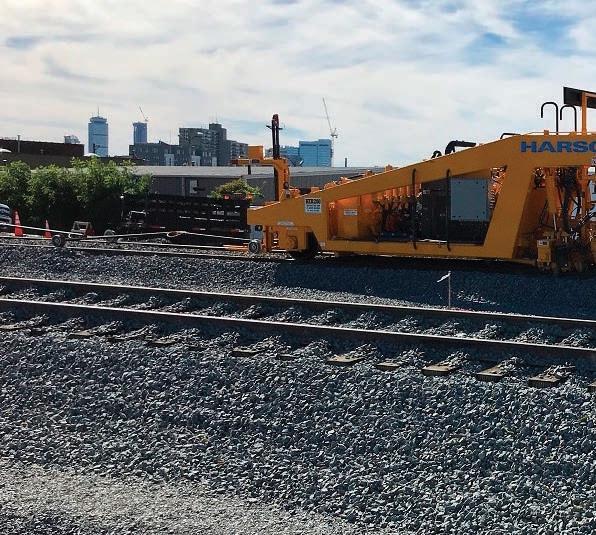


 By Jennifer McLawhorn, Managing Editor
By Jennifer McLawhorn, Managing Editor

usually starts with tamping machines that are highly technical and can correct the alignment down to the millimeter. In the past, track tamping was done by hand and required maintenance crews to perform back-breaking work to ensure there was enough ballast beneath the ties. The process of checking for
alignment was left to the sight of maintenance crews. However, due to human error, these early tamping methods were not as effective as that accomplished by today’s sophisticated machinery. Later, ballast tamping was performed by the trains that ran over it, with the trains simply running on the track,
compacting the ballast beneath the tie until it solidified.
Tamping machines utilize computers to measure and detect misalignments and the process involves ballast being compacted together under the ties to improve stability along the track. To provide proper load bearing, tamping
reduces movement of the track and rail. A motorized tamping machine is loaded onto the track via a hydraulic turntable with lifting cylinders. Once securely onto the track, the tamping machine is ready for use.
A tamping machine uses directional vibrations via an eccentric vibration shaft to allow tamping tines to enter the ballast more easily. Squeezing forces located on either side of the eccentric vibration shaft move the fixed pivot so the tamping tines can enter the ground. Each component works together to simultaneously lift the tie and pack the ballast underneath.
Four to eight pairs of tools, up to sixteen total, for each rail vibrate quickly to loosen the ballast as they are forced into the roadbed. These vibrations can reach 3,000 to 4,500 per minute. Once in the ground, the process of track tamping involves a machine with tamping tines that squeeze the ballast with equal pressure on either side of the rail. It is imperative that the pressure is equal on both
sides to provide an even amalgamation of ballast. This squeezing pushes the ballast up under the rail tie and reinforces support and stability.
over the years, concrete ties require the use of tamping machines due to their weight. These machines are equipped with track-lifting devices that can lift the rail and hold it in the correct position while the tamping tines work. A tamping machine can squeeze more ballast underneath a tie than workers can. Often used in conjunction with a ballast regulator to even out the ballast, tamping machinery can be simplistic in design or more advanced with other track maintenance features.
Tamping tines squeeze the ballast underneath the tie, effectively dealing with any potential gaps. While rail ties have been made from different materials

TrackSafetyStandards
TrackSafetyStandards, containstheTrackSafety Standards,SubpartsA-F,forClassesoftrack1-5.The standardscovergeneralinformation,Roadbed,Track Geometry,TrackStructure,TrackAppliancesand Track-RelatedDevices,andInspection.IncludesDefectCodes.
Updated January6,2023
BKTSSAF TrackSafetyStandards,SubpartsA-F $11.95
Only$10.75forordersof50ormore!
BridgeSafetyStandards
FRAPart237establishesFederalsafetyrequirements forrailroadbridges.Thisrulerequirestrackownersto implementbridgemanagementprograms,whichinclude annualinspectionsofrailroadbridges,andtoauditthe programs. Part237 alsorequirestrackownerstoknow thesafeloadcapacityofbridgesandtoconductspecialinspectionsif theweatherorotherconditionswarrantsuchinspections. Updated January6,2023.

The tamper itself has three trolleys. One is located at the front with another at the rear and a measuring trolley in the center. It measures the alignment by creating a straight line between these three trolleys. This straight line can be created with a wire or an infrared beam. Any longitudinal or lateral discrepancy in alignment is recorded and sent to the tamper’s computer.
Tamping can be completed around either a single tie, called spot-tamping, or several ties at once on a larger track
WorkplaceSafety
BKWRK RailroadWorkplaceSafety $11.50 Only$10.35forordersof50ormore!


TrackCalculator
BKTCAL TrackCalculator $11.50 Only$10.75forordersof50ormore!

maintenance project. If a section of track hasn’t received a lot of maintenance in a while because the amount and speed of trains along the line hasn’t called for it, at some point, it will be necessary to replace some ties and tamp and resurface the ballast. However, even track that is well maintained and sees heavy traffic or high speeds, may develop a spot or two where the ballast needs tamping. In addition, track that sees heavy tonnage and high-speed trains may need frequent maintenance, including tamping.
While the purpose of tamping is to compact and solidify the ballast, tamping actually loosens compaction around the ties. This issue can be addressed through train tamping, where trains are run over the recently tamped ballast at incremental weights and speeds. To save time, though, ballast compactors or dynamic track stabilizers can be used to accomplish this work, enabling freight and passenger traffic to resume normal speeds.
Today, there are several types of
tamping machines manufactured by companies like Plasser American, Ballast Tools, and Harsco Rail. Among these are duomatic or plain track tampers,
and multi-purpose machines. Its multipurpose machine, the Unimat Combi 08-275 is a single-tie tamping machine that has spot fault repair and noncontacting track geometry recording.

Track tamping machines can travel around 25 miles or 40 kilometers per hour or more, depending on the manufacturer. For example, Harsco Rail’s railway tamping machine, the TX16 Production/Switch Tamper can travel up to 30 miles or 48 kilometers per hour with a productivity rate of 30 ties per minute. These machines also have the capability to tamp ballast through switches.
points and crossing tampers, and multipurpose tampers. For example, Plasser & Theurer is one of the largest tamping machine manufacturers with universal
Because the tamping process includes a high vibration of ballast to allow the tamping tools to enter, it is important crews maintain the ballast afterward to be sure there are no areas of loose ballast within the roadbed. As the ballast is compacted under the ties during this track tamping process, maintenance crews supply additional ballast that allows them to shape the surface.
EVEN TRACK THAT IS WELL MAINTAINED AND SEES HEAVY TRAFFIC OR HIGH SPEEDS, MAY DEVELOP A SPOT OR TWO WHERE THE BALLAST NEEDS TAMPING.
Once again, I am leaning on my favorite president to introduce how AREMA is addressing Sustainability and Resilience. On August 31, 1910, eodore Roosevelt visited Osawatomie, Kansas and laid out his vision for what he called a “new nationalism.” “Of all the questions which can come before this nation, short of the actual preservation of its existence in a great war, there is none which compares in importance with the great central task of leaving this land even a better land for our descendants than it is for us.”
My May message introduced sustainability and discussed how it is being addressed by the railway industry. Resilience is equally important to our industry as we address the impacts of climate change and other exposures while meeting our obligations as a reliable common carrier. Staying true to our mission, AREMA has been reviewing how it will provide non-biased industry recommended practices and technical training that support these important subjects. As the pre-eminent railway engineering organization, AREMA must proactively address infrastructure sustainability and resilience.
With assistance of Committee 13 –Environmental (C13), led by Chair Kari Harris - Manager, Environmental Impact (US), CN Railway, AREMA prepared a Sustainability and Resilience Position Paper to summarize these dynamic subjects and outline an initial action plan. is paper has been under review and discussion within the AREMA Functional Group Board of Directors (BOD) and in March a nal version was approved. In June, the
GBOD discussed in further detail how this will be operationalized for the Technical Committees that maintain the manuals.
e Paper recognizes three developments in recent years. First, the North American and International railways and transit organizations are embedding sustainability into operations and setting science-based targets to reduce their greenhouse emissions. Second, the Security and Exchange Commission has proposed a climate-change disclosure rule that would require disclosure on climate-related risks, what the impacts might be, how those risks might a ect their business strategy and outlook, and how climaterelated events and transition activities impact their nancial statements. And third, Environmental, Social and Governance (ESG) principles are increasingly being used for investing and corporate decision making. ESG reporting includes how sustainability and resilience e orts are being addressed.
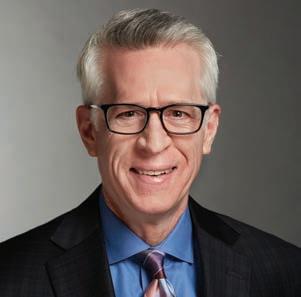
As discussed in my May message, the United Nations Sustainable Development Goals (SDGs) is the mostly widely accepted framework for addressing sustainability and will be utilized to guide AREMA’s e orts.
e mostly widely accepted and most objective de nition of infrastructure resilience is by the National Infrastructure Advisory Council (NIAC). ey state “it is the ability to reduce the magnitude and/or duration of disruptive events. e e ectiveness of a
resilient infrastructure or enterprise depends upon its ability to anticipate, absorb, adapt to, and/or rapidly recover from a potentially disruptive event.”
AREMA’s sustainability posture and plan will evolve over time. Although the SDG framework provides a starting point, continuous assessment of evolving ESG drivers, trends, and stakeholder needs should be anticipated. e AREMA Technical Committees will prioritize which sustainability indicators have an impact on the recommended practices, cross-collaborate among themselves, and determine short, mid, and long-term objectives to incorporate.
AREMA’s sustainability posture will be aligned for its members by ensuring our e orts are Relevant, Ready, and Responsive, three pillars of sustainability leadership. Collectively this is represented in AREMA’s Sustainability Framework gure above.

e Position Paper outlines an action plan that leverages Subcommittee A (a standing subcommittee that manages manual/ handbook material) of each committee.
ey will review the SDGs for applicability, review with C13 for alignment with all Technical Committees, develop new/updated sustainability and resilience material, and then ballot and publish manual/handbook updates. C13 will act as the primary body to operationalize and integrate the action plan by identifying Subcommittee A’s needs,
providing applicable training in collaboration with other committees, and facilitating structural alignment with AREMA. e Paper will be reviewed at least annually and updated as needed to re ect current industry practices. C13 will meet regularly to review and support practical solutions to meet the subcommittees’ needs to ensure a successful, integrated implementation. It is important to point out that each of AREMA’s Technical Committees responsible for manual recommended practices remain in full control of their respective material and will be following existing operating procedures and BOD approvals.
Addressing these subjects will align with the stated objectives of the AREMA Strategic Plan through Presence, Relevance, and Participation.
» Presence – penetrate the membership, reach the whole international railway industry, and be the professional association of choice for railway
engineering professionals;
» Relevance - publish materials re ecting current industry best practices, developed in a non-biased manner without commercial in uence, and approved in accordance with the Bylaws and Committee Regulations;
» Participation - ensure a broad spectrum of knowledge and experience is considered through the contribution of industry personnel with the appropriate technical expertise in the subject matter areas.
Additionally, a separate e ort has been underway this year to update the AREMA Strategic Plan. It is proposed that the vision set forth by this Position Paper be incorporated in the updated Strategic Plan.
Enjoy your journey until next month.
TRENT M. HUDAK AREMA President 2022-2023www.nps.gov
SEPTEMBER 30 - OCTOBER 1
Committee 24 - Education & Training
OCTOBER 1
Committee 11 - Commuter & Intercity Rail Systems
OCTOBER 1
Committee 16 - Economics of Railway Engineering & Operations
OCTOBER 2
Committee 18 - Light Density & Short Line Railways
Register now for the AREMA 2023 Annual Conference in conjunction with Railway Interchange. Railway Interchange is back after four years October 1-4 at the Indiana Convention Center. For the latest information about Keynote Speakers, Technical Presentations, Sponsorship, and more, visit www.conference.arema.org.
Did you know we have a wide variety of On Demand education for learning on your time? Browse our most popular webinars, seminars, and Annual Conferences to earn your PDH credits on the go. Visit www.arema.org to start your On Demand learning today. It features guests from every aspect of the railway industry. Available on all of your favorite listening service.
NOT AN AREMA MEMBER?
JOIN TODAY AT WWW.AREMA.ORG
CONNECT WITH AREMA ON SOCIAL MEDIA:
OCTOBER 1
Committee 12 - Rail Transit
OCTOBER 1
Committees 11 and 17 Joint Meeting
OCTOBER 1
Committee 14 - Yards & Terminals
OCTOBER 2
Committee 41 – Track Maintenance
OCTOBER 1
Committee 33 - Electric Energy Utilization
OCTOBER 1
Committee 10 – Structures Maintenance & Construction
OCTOBER 1
Committee 40Engineering Safety
OCTOBER 4-5
Committee 38 –Information, Defect Detection & Energy Systems
OCTOBER 1
Committee 17 - High Speed Rail Systems
OCTOBER 1
Committee 5 - Track
OCTOBER 2
Committee 13Environmental
OCTOBER 4-5
Committee 4 – Rail
Joining a technical committee is the starting point for involvement in the Association and an opportunity for lifelong growth in the industry. AREMA has 30 technical committees covering a broad spectrum of railway engineering specialties. Build your network of contacts, sharpen your leadership skills, learn from other members and maximize your membership investment. If you’re interested in joining a technical committee or sitting in on a meeting as a guest, please contact Alayne Bell at abell@arema.org.
For a complete list of all committee meetings, visit www.arema.org.
PE, F.SAME
Nominated For: Senior Vice President
Title: Chief Engineer Structures
Organization/Company: Genesee & Wyoming, Inc.
MR. RIEHL began his career as a Civil Engineer in 1987. He has been Chief Engineer with both Seminole Gulf Railway and Florida East Coast Railway, as well as President of Riehl Rail Solutions. He has been with Genesee & Wyoming, Inc. since October 2007 and is currently Chief Engineer Structures. He was also with the US Air Force Reserves since 1981 and retired Colonel in 2022 as IMA to Deputy Commander Air Force Civil Engineer Center.
He holds a BS Civil Engineering degree from Pennsylvania State University and an MS Industrial & Systems Engineering degree from the University of Florida. He has a Professional Engineer designation.
Mr. Riehl is an AREMA Life Member, as well as a member of AREMA Committees 7 and 24, previously serving as Chair of 24, and previous member of Committee 30, serving as Vice Chair. He also previously served on the AREMA Board of Directors as Director – Structures and currently as Functional Group Vice President – Structures. He is a member of the American Society of Civil Engineers and fellow of the Society of American Military Engineers. He is also a member of the Penn State Altoona Rail Transportation Engineering Advisory Board.
Matthew R. PortoJoined AREMA or Predecessor Organization: Joined AREA in 1987
Nominated For: Vice President –Maintenance-of-Way
(Three-Year Term/Re-elect)
Title: Senior Director Workforce Planning and Analytics

Organization/Company: AMTRAK
MR. PORTO started his career in 1999 in Semiconductor Technical with Rodel, Inc. He was R&D Metrology Technician and Semiconductor Metrology Engineer with Rohm and Haas Electronic Materials, then Semiconductor Metrology Engineer with Dow Chemical. He started with AMTRAK in 2011 as Environmental Coordinator, then Director of System Safety and Senior Manager Workforce Management, then Director of Data Analytics and Director Workforce Management to currently Senior Director Workforce Planning and Analytics.
He holds a BS degree in Physics from the University of Delaware and an MBA in International Business Management from Goldey-Beacom College.
Mr. Porto has served on the AREMA Board of Directors as Director of Maintenance-of-Way and currently Functional
Group Vice President – Maintenance-ofWay. He is a member of AREMA Committee 40, previously serving as Chair. He is also a member of the Fatality Analysis of Maintenance Employees and Signalmen as well as the Microscopy Society of America.
Walter F. Bleser, II, PEJoined AREMA or Predecessor Organization: Joined AREMA in 2013
Nominated For: Vice President –Structures (Three-Year Term)
Title: President & CEO
Organization/Company: ARE Corporation
MR. BLESER has spent his entire career in the railway bridge industry in roles that include bridge inspection, rating, design and construction management. He is the Founder of Unabridged Structures, LLC and currently President and CEO of ARE Corporation. His passion for the industry, combined with a tendency to look at “old problems” in an entirely new way enabled him to help create and lead the implementation of RailAdvise®, a railroad-based asset management so ware. A er creating the so ware, he co-founded SENSR Monitoring Technologies, LLC. Prior to SENSR, Mr. Bleser worked with Georgetown Rail Equipment Company (GREX) and HNTB Corporation in various project engineer and railway technology management roles.
He holds a BS Civil Engineering degree from Kansas State University and a Master’s Civil Engineering degree from the University of Kansas. He has a Professional Engineer designation.
Mr. Bleser is a member of AREMA Committees 7 and 10, previously serving as Secretary, Vice Chair and Chair of 7 and Subcommittee Chair of 10. He was recognized as a “Rising Star in the Railroad Industry” in 2013 by Progressive Railroading Magazine, and was recognized by Railway Age Magazine as a honorable mention for their “Fast Trackers” award in 2019. He is also a member of the National Eagle Scout Association.
Jason J. SchroederJoined AREMA or Predecessor Organization: Joined AREMA in 2005
Nominated For: Director – Communications, Signals & Information Technology (Three-Year Term)
Title: Assistant Chief Engineer Organization/Company: CSX Transportation
After working at The Ohio State University for a few years, MR. SCHROEDER has worked with CSX Transportation since 2003, as Signalman/Signal Maintainer, Signal Design Specialist, Manager Rail/ Transportation Projects, Director Service Test Engineering and currently Assistant Chief Engineer.
He holds a BS in Electrical and Computer Engineering from The Ohio State University. He also has completed Assistant Signalman Training from CSX Transportation and the Business Leadership Program from the University of Maryland.
Mr. Schroeder is a member of AREMA Committee 39 and former member of Committee 37. He is a member of Eastern Signal Engineers and North America Signal Engineers.
Amanda Stahlnecker, PE
Joined AREMA or Predecessor
Organization: Joined AREMA in 2005
Nominated For: Director – Engineering Services (Three-Year Term)
Title: Rail Section Manager
Organization/Company: HDR
MS. STAHLNECKER has worked at HDR since 2006 and is currently Rail Section Manager. She previously worked at Patrick Engineering 2004-2006 and had several rail internships 2000-2003.
She holds a BS Civil Engineering degree from the University of Nebraska-Lincoln. She has a Professional Engineer designation.
Ms. Stahlnecker is a member of AREMA Committee 24 and was previously the Chair, Vice Chair, Secretary. She has participated on the AREMA Membership and Nominating Committees. She is a member of the Society of Women Engineers. She is an AREMA TADS seminar instructor and was a Progressive Railroading Rising Star in 2017.
Sean
Joined AREMA or Predecessor Organization: Joined AREMA in 2003
Nominated For: Director – Passenger & Transit (Three-Year Term/Re-elect)
Title: Senior Project Engineer
Organization/Company: VHB, Inc.
MR. KULLEN began his career in 1994 as a Materials Testing Technician for VHB. He then went to HDR as Senior Rail Engineer in 2005. He returned to VHB as Senior Project Engineer in 2016, his current position. He has 28 years of experience in the rail transportation industry.
He holds a BS Civil Engineering degree from Worcester Polytechnic Institute and an MS Civil Engineering degree from Northwestern University. He has a Professional Engineer designation.
Mr. Kullen has been a member of AREMA Committee 11 since 2009 and Committee 17 since 2013. He served as Chair, Vice Chair and Secretary of Committee 11. He is currently AREMA Director – Passenger & Transit. He is a member of the American Society of Quality and is the Boston Section Scholarship Chair.
John R. Jerome
Joined AREMA or Predecessor Organization: Joined AREMA in 2009
Nominated For: Director – Track (Three-Year Term)
Title: General Director Track Programs
Organization/Company: Union Pacific
MR. JEROME began his career with SCI Engineering in 1996. He moved to a position with the City of Fort Dodge, IA in 2001 and then to Union Paci c in 2006. His current position is General Director Track Programs.
He holds a BS in Business Administration from William Penn University and an MBA from California Coast University. He completed the Union Paci c Railroad Executive Leadership Development Program in 2018.
Mr. Jerome is a member of AREMA Committee 5 and was past chair of Subcommittee 7. He was a previous member of the AREMA Nominating Committee. He is a member of the American Legion and the Marine Corps League (a er a prestigious 6-year career in the U.S. Marine Corps).



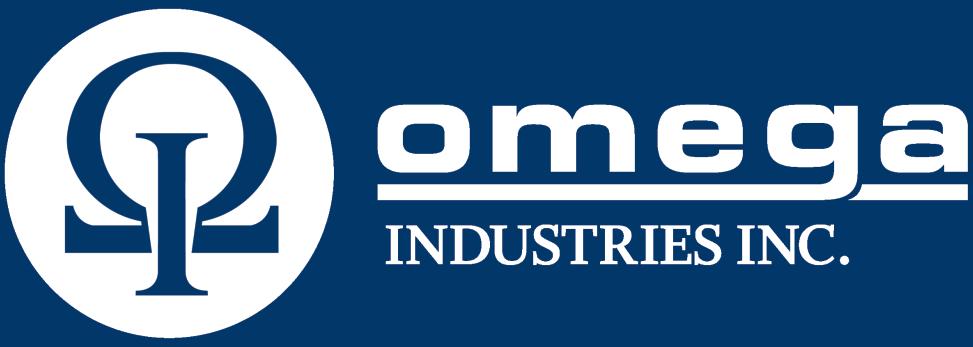


MAIN OFFICE
JONATHAN CHALON Publisher (212) 620-7224 jchalon@sbpub.com
AL, KY, TN, CHINA
JONATHAN CHALON (212) 620-7224
jchalon@sbpub.com
CT, DE, DC, FL, GA, ME,MD, MA, NH, NJ, NY, NC, OH, PA,RI, SC, VT, VA, WV, CANADA: QUEBEC AND EAST, ONTARIO
JEROME MARULLO (212) 620-7260
jmarullo@sbpub.com
AR, AK, AZ, CA, CO, IA, ID, IL, IN, KS, LA, MI, MN, MO, MS, MT, NE, NM, ND, NV, OK, OR, SD, TX, UT, WA, WI, WY, CANADA: ALBERTA, BRITISH COLUMBIA, MANITOBA, SASKATCHEWAN HEATHER DISABATO (CHICAGO OFFICE) (312) 683-5026 hdisabato@sbpub.com
AMERICAS, EUROPE, ASIA, AFRICA, AUSTRAL ASIA NORTH AMERICA - CT, DE, DC, FL, GA, ME, MD, MA, NH, NJ, NY, NC, OH, PA, RI, SC, VT, VA, WV, AND EASTERN CANADA. EUROPE EXCEPT GERMANY, AUSTRIA, GERMAN SPEAKING SWITZERLAND, EASTERN EUROPE, ITALY, AND ITALIAN-SPEAKING SWITZERLAND. ASIA EXCEPT JAPAN AND CHINA. JEROME MARULLO (212) 620-7260 jmarullo@sbpub.com
GERMANY, AUSTRIA, GERMAN-SPEAKING SWITZERLAND, LATVIA, LITHUANIA, ESTONIA, POLAND, CZECH REPUBLIC, SLOVAKIA, HUNGARY, SLOVENIA, CROATIA AND SERBIA SIMONE AND SIMON FAHR
Breitenbergstr. 17
Füssen 87629
Germany
Tel: +49 8362 5074996 sfahr@railjournal.com
ITALY, ITALIAN-SPEAKING
SWITZERLAND
DR. FABIO POTESTA
Media Point & Communications SRL
Corte Lambruschini
Corso Buenos Aires 8 V Piano, Genoa, Italy 16129 +39-10-570-4948
Fax: +39-10-553-0088 info@mediapointsrl.it
JAPAN
KATSUHIRO ISHII
Ace Media Service, Inc. 12-6 4-Chome, Nishiiko, Adachi-Ku
Tokyo 121-0824
Japan
+81-3-5691-3335
Fax: +81-3-5691-3336 amkatsu@dream.com
IRJ PRO AND CLASSIFIED ADVERTISING SALES
JEROME MARULLO
(212) 620-7260 jmarullo@sbpub.com
This section has been created solely for the convenience of our readers to facilitate immediate
advertisers in this issue. The Advertisers Index is an editorial feature maintained for the convenience of readers. It is not part of the
contract and RTS assumes no responsibility for the correctness.
The short line industry is being battered about these days by proposed federal legislation that is slow to move and overly aggressive state legislation that borders on being laughable. I’m talking, of course, about the proposed Short Line Railroad Relief Act sitting in the U.S. Congress and the California Air Resources Board’s proposed In-Use Locomotive Rule.
Readers will recall that the Short Line Railroad Relief Act largely stems from Hurricane Ian’s destruction on the Seminole Gulf Railway less than a year ago. A er this storm devastated most of this railroad, it raised concern about the lack of federal disaster relief available for short lines. States certainly can’t take this on by themselves, and Congressman Byron Donalds (R-Fla.) introduced legislation in the last Congress and the current one to make federal dollars available to help short lines recover from natural disasters. Congressman Donalds recently stated in a press release that “When a storm of this magnitude hits any area of our nation, it is the federal government’s responsibility to make available the necessary resources to rebuild and restore vital components of a community. As Hurricane Season 2023 begins, we must establish a means by which America’s short line railroads can receive critical relief a er natural disasters.”
American Short Line and Regional Railroad Association President and CEO Chuck Baker recently added that “In the event of a natural disaster, short line railroads can play a critical recovery role, moving relief goods in and debris of all kinds out, yet no signicant federal disaster relief options are available to them beyond small loans.” Baker went on to say that “ e Short Line Railroad Relief Act would provide parity across transportation modes, allowing for immediate deployment of grant funding to short line railroads, enabling them to turn their attention to rebuilding the local economy, particularly crucial in the small town and rural communities that we serve. Representative Donalds jumped into action by the devastation to the Seminole Gulf Railway in his district caused by Hurricane Ian last year. e concern,
however, is applicable nationwide, resulting in Congressional support throughout the country for this e ort. We applaud each of the cosponsoring members of Congress for their leadership.” Baker’s point on the critical recovery role short line railroads can play echoed in an interview I had last year with Robert Fay, Vice President of Seminole Gulf, where he said that in Florida’s numerous hurricanes, oods, and other disasters, his railroad has usually been a critical part of the recovery, not the object of devastation.
Just before press time, I spoke again with Robert Fay at the Seminole Gulf. He reported that he and others had spent time in Washington lobbying Congress to pass e Short Line Railroad Relief Act. Over the past several months, Fay’s team has managed to repair one of their major bridges lost in the hurricane and replace 40 miles of track, but they had to obtain private bank loans to fund the work. e restoration of this portion of his line has allowed the Seminole Gulf to resume service to six customers, and Fay has attracted some new customers to his line.
On the other side of the country, we now have the California Air Resources Board (CARB) taking us from the sublime (if the relief act becomes law) to the absurd. is agency has mandated that locomotive operators in California begin paying into a spending account beginning in October of this year, and the level of emissions their locomotives create while running in California will determine the amount they must pay.
is mandate is called the “In-Use Locomotive Rule.” Companies can use the funds to upgrade to cleaner locomotive technologies, and the rule also stipulates that locomotives will have a 30-minute idling limit. Additionally, switch, industrial, and passenger locomotives built in 2030 or a er will be required to operate in zero-emissions con gurations in California and 2035 for freight line haul.
Make no mistake – I am as concerned about the environment as anyone is. Melting ice caps, wild res, massive hurricanes, and other violent weather caused by global warming demand society’s most serious attention. However, forcing short line railroads, many of which face revenue and tra c
challenges, to begin paying into an emissions technology fund on such short notice is ridiculous.
e Association of American Railroads and the American Short Line & Regional Railroad Association have led a lawsuit in the Eastern District of California and “argue that CARB lacks the legal authority to promulgate the In-Use Locomotive Rule. Due to the interconnected nature of rail operations and the need for uniform regulatory policies, Congress, the courts, federal regulators, and even CARB itself have long acknowledged that the federal government has exclusive authority to regulate rail operations.” Ian Je eries, the President and CEO of the AAR, said [w]hile the urgency to act is real and unquestionable, CARB uses unreasonable, awed assumptions to support a rule that will not result in emissions reductions. Railroads have urged CARB to take the proven path of collaboration and build on our shared successes, but those arguments were rejected out of hand. Railroads are working toward reliable, ecient zero-emissions technologies; however, they cannot simply be willed into immediate existence by policymakers.” e AAR and ASLRRA also point out that zero-emissions technology “has not been su ciently tested in prototype or operational service and is not commercially available on the market today.” ey also point out that “a clear technological path has not yet emerged.”
Railroads are already the most fuel-ecient form of land transportation. Moreover, the industry, according to the AAR and ASLRRA, has initiatives underway, such as zero-emissions cranes and yard service vehicles. Other technology is at work in California and the nation, such as anti-idling systems and fuel management systems, which are reducing locomotive emissions. Additionally, the industry is testing technologies such as battery-electric, hydrogen fuel cell power, and renewable fuels.
ASLRRA’s Baker said that “[w]hile the spirit behind this regulation is consistent with the railroads’ environmental commitment . . . [this rule] would literally bankrupt some small business short lines.”











TheAREMA2023AnnualConferenceinconjunctionwith RailwayInterchangeisbackafterfouryears.Joinusto network,expandyourknowledgefromthenearly80Technical Presentations,findsolutionsintheExhibitHallfeaturingover 700companies,andmuchmore.











